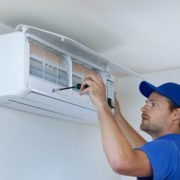Carbon Monoxide: What You Don’t Know is Putting Your Family at Risk
“It started as a nagging headache,” Diane said. “And then it became worse before turning into a horror show.”
It was around 9 pm on a cold December night and both of them were sitting in front of their fireplace, decompressing from the hard day’s work. The baby June was in her crib. Suddenly, Liam, Diane’s husband, became sick – headache, vomiting, the works. That made Diane concerned for her husband’s health but she chalked it up to the bug that was going around the neighborhood. “Must be the flu.”
Two hours later, Diane felt her heart thudding in her chest, wanting to come out. She became nauseous and lightheaded, and her whole body went cold. She panicked and rushed to “Google” the symptoms – finding it just might be Carbon Monoxide poisoning. She called 911 after finding out that they were indeed being poisoned by the stealthiest killer: Carbon Monoxide.
Her family was saved thanks to Diane’s quick reaction and pure timing but, everyone is not so lucky.
List of Contents
What is Carbon Monoxide?
CO is a colorless, tasteless, and odorless gas. That means between 1999 to 2010 most of the 5,149 Americans that ended up in graves because of non-fire-related Carbon Monoxide poisoning had no idea what hit them. No bad odor, no horrible taste, nothing – except for the untimely death.
Although, like all accidents you can minimize the chances of dying from CO, most people avoid taking the right precautionary measures until it happens to them. When, unfortunately, it is already too late. And the damage is done.
CO is produced any time you burn fossil fuels like in cars, trucks, fireplaces, and good old furnaces. Everyone is at risk regardless of gender or age, but children and elderly and those with preexisting diseases of heart or lungs are at higher risk of developing complications such as permanent brain damage, life-threatening heart complications, and death.
How Does Carbon Monoxide Affect Our Health?
Once inhaled, it goes into the blood stream and displaces oxygen from hemoglobin, that results in a deficiency of oxygen which leads to hypoxia and eventually death.
The symptoms of CO are non-specific and often don’t tell anything by themselves. Most common symptoms include altered mental status, headache, nausea, weakness and chest pain.
Fortunately, science has made it really easy to prevent against CO exposure. Take steps to prevent accidental exposure to Carbon Monoxide. Because it is real. And it kills.
How to Avoid Carbon Monoxide Poisoning
Here are just a few ways that you can avoid carbon monoxide poisoning:
1. Install and maintain a CO detector: This is the single most important thing you can do to protect your family against the possibility of Carbon Monoxide poisoning. Make sure to buy a battery operated detector with a loud enough alarm to wake you up. But that’s not all, replace the battery every year and change the detector once every 5 years.
2. Don’t use portable gas camp stoves indoors. Small appliances like these also contribute to the buildup of Carbon Monoxide and when indoors, the harmful gasses can’t escape and your family can’t escape from them. Get rid of them folks.
3. Get your gas appliances checked by an expert. Make sure that they are working correctly and all the stuff that is supposed to be inside is staying inside and not spilling out to kill you when you’re asleep.
4. Never ignore any unusual odor coming from your refrigerator. CO itself has no odor, but in this case, other gasses mixed with CO have a particular odor that might give it away.
5. Clean your chimney. Debris can clog up your chimney real bad. So, now all the gasses would accumulate inside your living room instead of escaping through the chimney. Get your chimney cleaned before it cleans you.
6. Be smart. Don’t burn charcoal indoors, use generators inside of your home or basement, or patch a vent pipe with chewing gum. We’ve seen it all and it’s always dangerous.
One last thing, if you ever suspect that you or a family member has been exposed to Carbon Monoxide, immediately evacuate the house and call 911. Learn more about how to maintain healthy air quality in your home and to have your HVAC system checked for safety, and contact us to schedule an inspection with us today!









